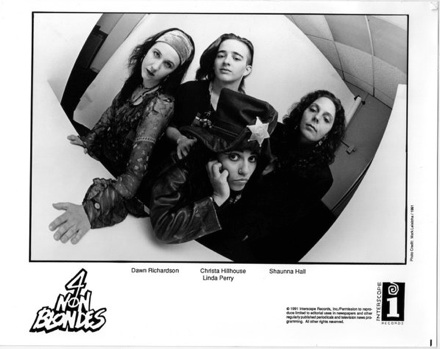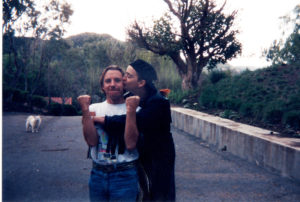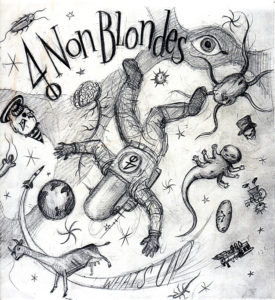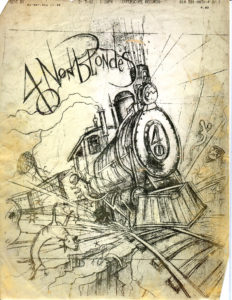

We began preproduction for our major label debut in the fall of 1991. Preproduction, for us at least, generally consisted of running through songs for David and discussing arrangements, etc. We felt we had the material to make a great record. A portion of that responsibility would rest on David’s shoulders; he needed to take a bunch of great songs and make a great album from them. The record needs to play well, song flowing into song, mood elevating and evolving throughout. His ears mattered.
Preproduction required more room and better sound than was supplied by our small rehearsal space; we needed a bigger studio with a better PA. Kat told us we would be using Capp Street Studios. I took pause at that; I was friends with the people that ran the studio, but it was basically a dump, as studios go. I went to NA meetings there sometimes. Midnight meetings full of ex-addict musicians. And the studio was located in one of the worst neighborhoods in San Francisco, between 16th and 17th on Capp street in the Mission. A plethora of drug dealers and street hookers, gangs and junkies. Why didn’t our manager get some advance money and get us a decent studio? You’d have to ask her. I recall her saying “Well, you guys are from the street – and I thought you’d be more comfortable there.” She didn’t have a fucking clue as far as I could tell.
I used to live nearby, two blocks away on 14th street, but I wasn’t in recovery back then and I always carried a weapon of some kind. And I would get my crazy face on if I had to, no problem. That area was a shithole. I remember feeling self conscious about being there when David first showed up. It was just a sleazy area and he was not a sleazy guy.
We wrapped it up one evening, a little after 7:00 pm. It wasn’t even dark yet. As the five of us walked down Capp Street towards 16th street to our respective rides and homes, two men approached us. One had a .38 caliber and he grabbed Dawn and put the gun up to her temple. The other man demanded our money. We had less than $5 between the 4 of us, and David had just returned from France and only had a bunch of french francs, and he handed them over. The man insisted we hand over our backpacks, which lacked any contents of real value but included a few walkman players. Mine had some cassette tapes of some old friend’s bands, and were not replaceable. I told the man that I had no money and he punched me in the face. He had a cast on his hand, so it hurt like hell. I gave him my bag, as did Shaunna and the two men ran off to a car waiting around the corner.
I remember running after them, trying to get a license tag number but not being able to see it clearly. There was a little police booth on the corner of 16th & Mission, only a block away. I ran to the booth and told the policeman inside that we had just been robbed at gunpoint. Cops came, a report was filed. Everyone went home. My lip started to swell up like a balloon.
I felt uneasy going out at night by myself for the next few weeks but it passed. I was still attending groups at Waldenhouse, but suddenly I wasn’t really participating. I was in groups with men who had been in prison and I think the vibe just shut me down. I didn’t want to say anything, didn’t want to make myself vulnerable at all. I was there physically but emotionally I was checked out.
It happened so fast, and we were somewhat shell shocked from it – and then we just moved on. Within a week we were driving to Los Angeles to begin recording our debut album. I don’t remember ever discussing the incident with any of the band members, not that there appeared any real reason to. But that guy that hit me, well, I never forgot his face. And several months later my memory of that evening would serve to convict him and put him in prison.
 We began basic tracks in November 1991 at Groove Masters studio in Santa Monica. The eventual instrumentation, vocals, and mixing would be done at David’s home studio – “the Bunker” – in the mountains of Calabasas. Basic tracks are, in layman’s terms, generally the bass and drums – and Dawn and I nailed our tracks. Every day we would run one song over and over until David felt like we had given the performance he was looking for. We were focused and tight and I liked what I heard. Our tracks sounded amazing.
We began basic tracks in November 1991 at Groove Masters studio in Santa Monica. The eventual instrumentation, vocals, and mixing would be done at David’s home studio – “the Bunker” – in the mountains of Calabasas. Basic tracks are, in layman’s terms, generally the bass and drums – and Dawn and I nailed our tracks. Every day we would run one song over and over until David felt like we had given the performance he was looking for. We were focused and tight and I liked what I heard. Our tracks sounded amazing.
The process of recording magnifies everything; if you are playing well it sounds magical, but if you are off your game it becomes obvious very quickly. As the rhythm tracks and acoustic guitar tracks were completed it was time to record the electric guitar parts and Shaunna was having problems holding up her end. Executing her parts seemed a struggle and her guitar playing sounded weak against the other instruments. The project came to a grinding halt.
4 Non Blondes was a band but it was also a collective, a churning mixture of personalities, common goals, and individual aspirations. When the band was in it’s infancy Shaunna wrote most of the material. But as the band evolved it became clear that our strongest songs were Linda’s compositions because, simply put, she liked to sing her own songs. And we had already gone through changes: the foundation of the band had been rocked by my addiction issues and Wanda’s departure. Dawn didn’t have a long history with Linda, Shaunna, and I and so the sentiment that perhaps serves as the glue in some bands wasn’t quite there for us at this point.
David wanted to pull in a session guitarist to record the parts, but Shaunna refused. She asked for more time and we gave her a month, but nothing really elevated except the level of tension in the room. We took another break and Shaunna was sent back to San Francisco. Linda, Dawn and I had a meeting and decided that Shaunna was out of the band. We would have to find someone else to complete the record and eventually tour with us.
In a later interview with Joel Selvin (SF Chronicle 8/93), Shaunna was quoted as saying:
“I had a choice. I was asked to let a session guy come in. I probably could have stayed with the group. But I couldn’t do that. I was a very young musician with little studio experience. Recording was a hardship for me. But I don’t feel like I got any support from my friends. It came down to a big money and ego trip. Linda had a dream and she wasn’t going to let anything get in the way, even if that meant writing off your guitar player.”

Laurent Tardy, Christa Hillhouse, Louis Matoyer, David Tickle, Linda Perry and David’s dog 1992 at David’s house.
As for me, I knew the devistating effect the decision would have on my friendship with Shaunna. But I was also, in ways, fighting for my own survival. I continued to deal with my addiction issues. I had been clean and sober for 9 months and was away from my support system of groups and meetings for the first time. The process of recovery, when successful, needs to be a very selfish one. It’s the only way to get through it. My playing was better than ever and my playing was the one thing that kept me in the band. I did feel I was absolutely irreplaceable musically. Right or wrong, I wasn’t worried about my future with the band as long as I stayed clean. And I wasn’t going to fight with Linda about Shaunna. I wanted to do whatever I could to support Linda and that enthusiasm would continue for the life of the band. I felt very confident in Linda’s ability to lead us to success. And more importantly I loved playing music with her.
We auditioned several guitarists and none of them clicked. It was somewhat discouraging until a tall, handsome guy named Louis Matoyer walked in and started playing. He was amazing; his versatility and tone sounded perfect along side our music. He had a great vibe. The four of us got got along really well. We had found our guitarist. The mood elevated and, once again, we were excited about the future.
Another crucial piece of the puzzle was choosing an artist to create our cover art. We were given several portfolios to look through, and chose Mark Ryden based on his recent artwork for the Warrant cover. He had a lot of great ideas, one of my favorites was of a group of three elementary school-aged brunette girls kicking a blonde girl. It wasn’t quite the representation we were looking for but it was a great drawing nonetheless.
Here are two sketches he faxed over to Interscope Records, including the rough concept that would become our cover:





